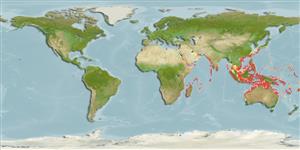Classification / Names
Common names from other countries
Main reference
Size / Weight / Age
Max length : 76.0 cm TL male/unsexed; (Ref. 6492)
Length at first maturity
Lm ?, range 42 - ? cm
Environment
Marine; reef-associated; depth range 2 - 65 m (Ref. 9710)
Climate / Range
Tropical, preferred ?; 35°N - 35°S, 26°E - 180°E (Ref. 5222)
Distribution
Indo-Pacific: East Africa south to East London, South Africa and east to Fiji. Recently recorded from Tonga (Ref. 53797). It is not known from the Red Sea, but it does occur in the Persian Gulf. Record from northwestern Australia (Ref. 3132) is doubtful. It is closely related to, and is often confused with, three other white-spotted species: Epinephelus ongus, Epinephelus summana, and Epinephelus corallicola.
Countries | FAO areas | Ecosystems | Occurrences | Introductions
Short description
Dorsal
spines
(total): 11;
Dorsal
soft rays
(total): 15-17;
Anal
spines: 3;
Anal
soft rays: 8. Characterized by brownish grey to charcoal color; head, body and dorsal fin with irregular-shaped white spots and blotches of variable size; adults with ctenoid scales on body in broad zone along middle of side, cycloid elsewhere; body of adult with numerous auxiliary scales; greatest depth of body 3.0-3.4 in SL; rounded caudal fin; short pelvic fins, 2.0-2.7 in head length (Ref. 90102); head length 2.3-2.5 times in SL; head pointed, interorbital area usually flat, and the dorsal profile almost straight; preopercle rounded, finely serrate; inconspicuous opercular spines; straight, sinuous or slightly concave upper edge of operculum; maxilla naked, mostly covered by upper lip; small or absent canines at front of jaws; 3-5 rows of small teeth in midlateral part of lower jaw (Ref. 089707).
IUCN Red List Status (Ref. 115185)
Threat to humans
Harmless
Human uses
Fisheries: minor commercial
More information
ReferencesAquacultureAquaculture profileStrainsGeneticsAllele frequenciesHeritabilityDiseasesProcessingMass conversion
Tools
Special reports
Download XML
Internet sources
Estimates of some properties based on models
Phylogenetic diversity index
PD50 = 0.5000 many relatives (e.g. carps) 0.5 - 2.0 few relatives (e.g. lungfishes)
Trophic Level
3.7 ±0.5 se; Based on diet studies.
Resilience
Low, minimum population doubling time 4.5 - 14 years (Preliminary K or Fecundity.)
Vulnerability
High vulnerability (57 of 100)
Price category
